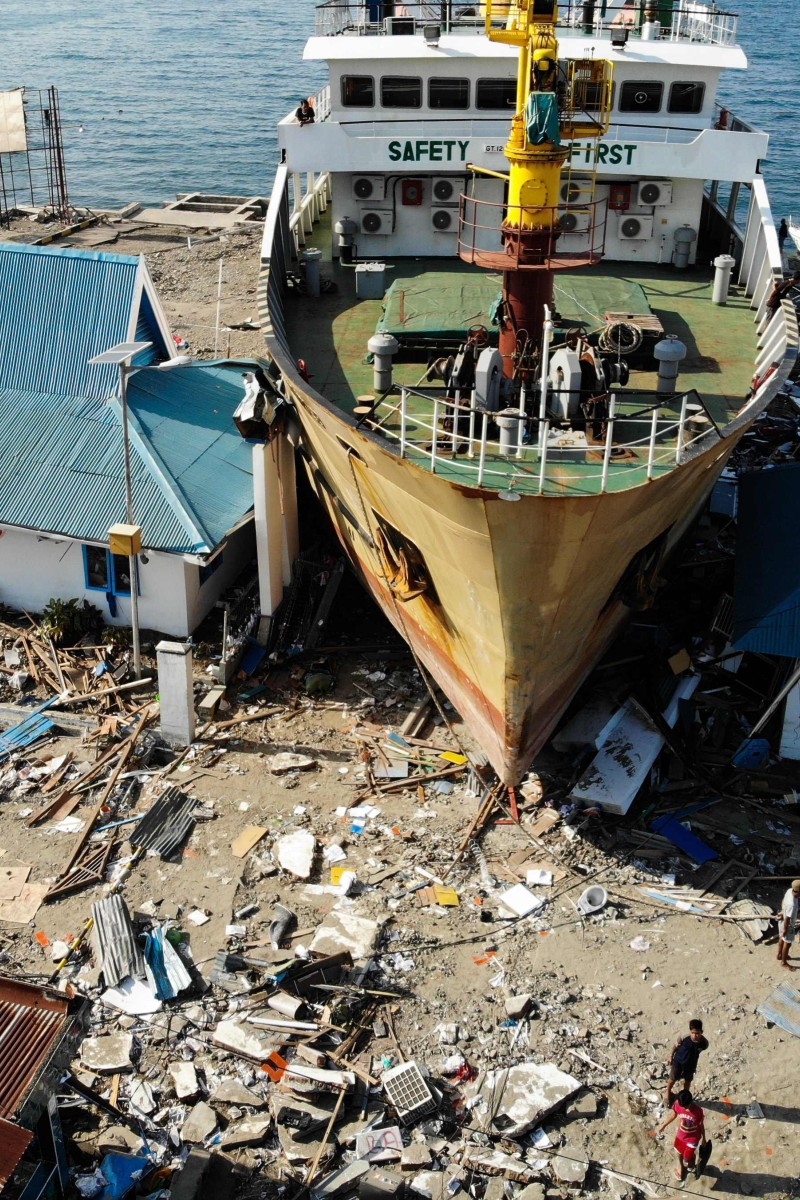 A passenger ferry that was washed ashore into buildings in Wani on Indonesia's island of Sulawesi.
A passenger ferry that was washed ashore into buildings in Wani on Indonesia's island of Sulawesi.Aid was trickling into areas hit hard by the earthquake and tsunami that struck the central Indonesian island of Sulawesi. One neighborhood’s residents were clapping, cheering and high-fiving in their excitement Wednesday at seeing a truck arrive with supplies.
“I’m so happy,” said Heruwanto, 63, who goes by one name. He was clutching a box of instant noodles. “I really haven’t eaten for three days.”
Food, water, fuel and medicine had yet to reach the hardest-hit areas outside Palu, the largest city heavily damaged in Friday’s disasters. Many roads were broken and split by the violent shaking or are blocked by debris and communications lines are down in the damage zone.
Indonesia tsunami 2018: Death toll rises to more than 1,200 on island of Sulawesi
“We feel like we are stepchildren here because all the help is going to Palu,” said Mohamad Taufik, 38, from the town of Donggala, where five of his relatives are still missing. “There are many young children here who are hungry and sick, but there is no milk or medicine.”
The official death toll is 1,234 and hundreds were injured, but officials acknowledge many uncounted bodies could still be buried in collapsed buildings in Sigi and Balaroa.
The United Nations humanitarian office said “needs are vast,” with people urgently requiring shelter, clean water, food, fuel and emergency medical care.
Water is the main issue because most of the supply infrastructure has been damaged, UN deputy spokesman Farhan Haq told reporters at UN headquarters in New York.
More than 25 countries offered assistance after Indonesian President Joko “Jokowi” Widodo appealed for international help. Little of that, however, has reached the disaster zone, and increasingly desperate residents grabbed food and fuel from damaged stores and begged for help.
An aircraft carrying 12,000 litres of fuel had arrived, and trucks with food were on the way with police escorts to guard against looters. Many gas stations were cloased either because of quake damage or from people stealing fuel, national disaster agency spokesman Sutopo Purwo Nugroho said in Jakarta.
What is liquefaction and how did it make the Indonesia earthquake and tsunami worse?
The frustration of waiting for days without help has angered some survivors.
“Pay attention to Donggala, Mr. Jokowi. Pay attention to Donggala,” yelled one resident in a video broadcast on local TV, referring to the president. “There are still a lot of unattended villages here.”
Nearly 62,000 people have been displaced from their homes, Nugroho said.
Teams continued searching for survivors under destroyed homes and buildings.
Many people were believed trapped under shattered houses in the Palu neighbourhood of Balaroa, where the earthquake caused the ground to move up and down violently.
Sa’Adon Lawira, who lost a grandchild, was angry that rescue efforts focused so quickly on places such as the Palu hotel where tourists were staying.
“Why did the search-and-rescue agency and others prioritise the search for victims in hotels?” he said, holding back tears as he spoke. “Neighbourhoods like this should take precedence because the bodies of residents are buried, but there are no rescuers who have searched for them.”
Hurricanes Harvey and Irma were hard, but most of the world’s disasters are ignored
Near the coast, the tsunami shattered buildings, uprooted concrete and thrust boats inland. The deadly wave reportedly reached as high as 6 metres in places.
Australia announced it will send 50 medical professionals as part of a $3.6 million aid package. The United States and China are among other countries that have offered assistance.
Indonesia, a vast archipelago of 260 million people, is frequently struck by earthquakes, volcanic eruptions and tsunamis because of its location on the “Ring of Fire,” an arc of volcanoes and fault lines in the Pacific Basin. A powerful quake on the island of Lombok killed 505 people in August.
